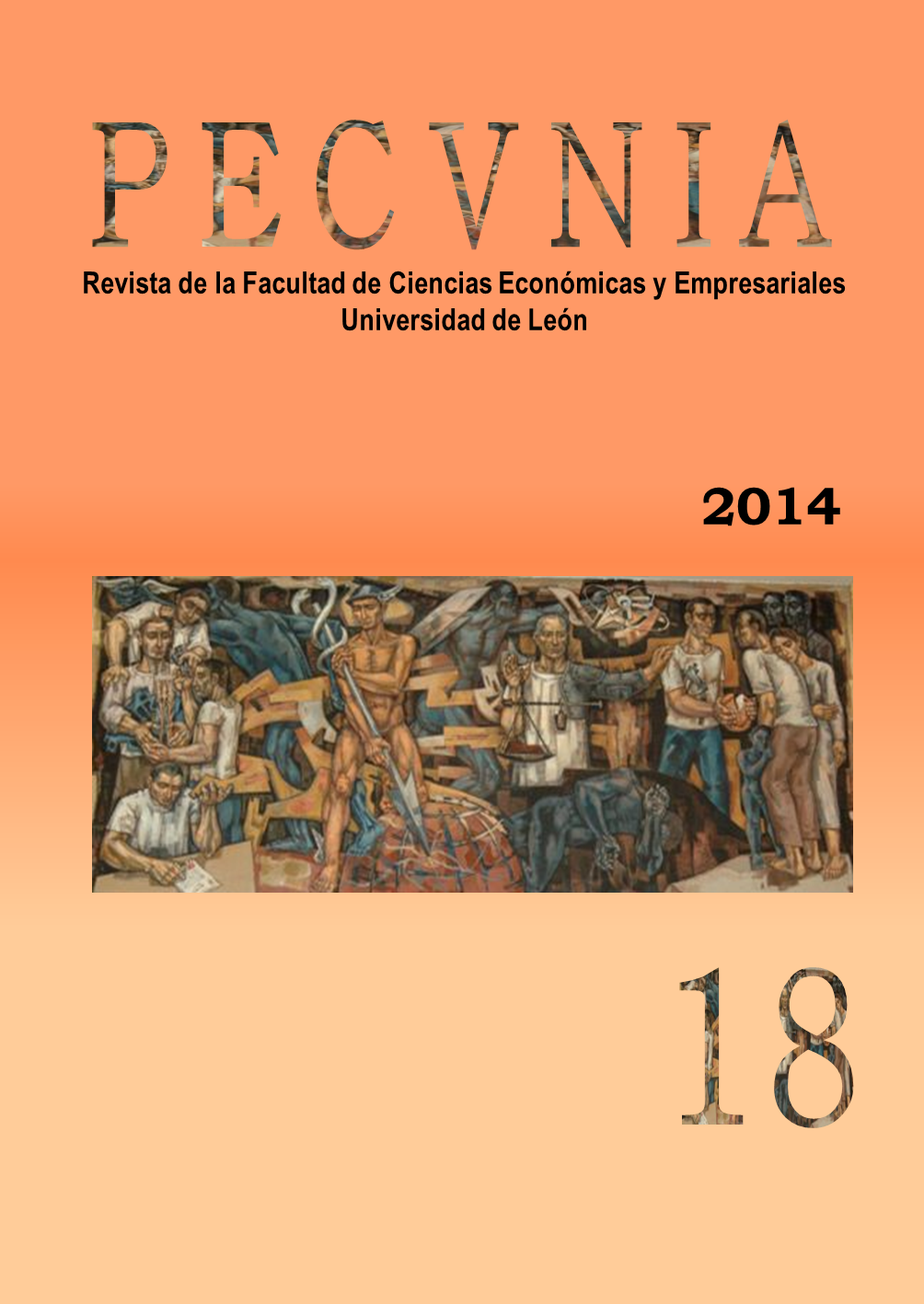Individuos centrales como protagonistas del proceso de innovación: un estudio con blogs españoles relacionados con alimentación = Central individuals as leading actors in the innovation process: a case study with Spanish food-related weblogs
DOI:
https://doi.org/10.18002/pec.v0i18.1648Palavras-chave:
Alimentación, Innovación abierta, Blogs online, Consumidor innovador, Centralidad, Food, Open innovation, Online weblogs, Consumer-innovator, CentralityResumo
En el momento actual, el sector agroalimentario español atraviesa una de sus etapas más inciertas. Mientras el consumo extradoméstico se desploma, el doméstico se ralentiza por la búsqueda de fórmulas más racionales que resulten en un menor gasto. Las exportaciones, la válvula de escape, crecen a ritmos nunca antes vistos abriéndose paso en escenarios internacionales especialmente regulados. Como consecuencia de este entorno, el esfuerzo dirigido hacia la innovación se convierte en ineludible para las compañías del sector. Ante este hecho, el mismo consumidor se perfila como un recurso muy importante para la obtención de información acerca de nuevas ideas y necesidades no satisfechas que, gracias a Internet y a la Web 2.0, se encuentra ahora más que nunca al alcance de la empresa. Este trabajo de investigación aborda el estudio de una de estas redes sociales online, basado en el examen del comportamiento innovador de los individuos que las forman y en la identificación de aquéllos que socialmente destacan sobre los demás. El documento finaliza con una reflexión y justificación globales e indica además ciertos aspectos de utilidad para el mundo empresarial y sendas líneas de investigación futura.
The Spanish food sector experiences at the present an especially uncertain conjunction. Whereas the extra-domestic consumption collapses, the domestic consumption slows down. Moreover, consumers look for more rational options at lower costs. In contrast, exports grow at really high rates in particularly regulated international scenarios. As a result of this scene, innovation efforts are unavoidable for food companies. In view of this, the very consumer, who is now easily reachable on the Internet and Web 2.0, represents a valuable resource for obtaining information about new ideas and uncovered needs. This research paper, working with one of these online social networks, presents an examination of the innovative behavior of individuals who conform them and identifies those who are more socially prominent when compared to the rest. Finally, the study concludes indicating aspects of general concern as well as some brief pieces of advice for practitioners and possible future lines of research
Downloads
Referências
Arndt, J. (1967). Role of product-related conversations in the diffusion of a new product. Journal of Marketing Research, 4(3), 291-295.
Bae, S. y Lee, T. (2011). Product type and consumers’ perception of online consumer reviews. Electronic Markets, 21(4), 255–266.
Balagué, C. y de Valck, K. (2013). Using blogs to solicit consumer feedback: The role of directive questioning versus no questioning. Journal of Interactive Marketing, 27(1), 62–73.
Barclay, D., Higgins, C. y Thompson, R. (1995). The partial least squares (PLS) approach to causal modeling: Personal computer adoption and use as an illustration. Technology Studies, (2), 285-309.
Barltett, M.S. (1954). A note on the multiplying factors for various chi square approximations. Journal of the Royal Statistical Society, (16), 296-298.
Becheur, A. y Gollety, M. (2006). Validation d'une échelle de mesure du lead user. Revue Française du Marketing, 206(1/5), 29-39.
Bonacich, P. (2007). Some unique properties of eigenvector centrality. Social Networks, 29(4), 555-564.
Borgatti, S.P. (2002). NetDraw: Graph visualization software. Harvard, MA: Analytic Technologies.
Borgatti, S.P., Everett, M.G. y Freeman, L.C. (2002). Ucinet for windows: Software for social network analysis. Harvard, MA: Analytic Technologies.
Brown, J.J. y Reingen, P.H. (1987). Social ties and word-of-mouth referral behavior. Journal of Consumer Research, 14(3), 350-362.
Christiansen, T. y Tax, S.S. (2000). Measuring word of mouth: The questions of who and when? Journal of Marketing Communications, 6(3), 185-199.
Coleman, J., Katz, E. y Menzel, H. (1966). Medical innovation: A diffusion study. Nueva York: Bobbs-Merry.
Darden, W.R. y Reynolds, F.D. (1972). Predicting opinion leadership for men's apparel fashions. Journal of Marketing Research, 9(3), 324-328.
Datta, P.R., Chowdhury, D.N. y Chakraborty, B.R. (2005). Viral marketing: New form of word-of-mouth through Internet. The Cambridge Business Review, 3(2), 69-75.
Droge, C., Stanko, M.A. y Pollitte, W.A. (2010). Lead users and early adopters on the web: The role of new technology product blogs. Journal of Product Innovation Management, 27(1), 66–82.
Edison, S.W. y Geissler, G.L. (2011). An investigation of negative word-of-mouth communication among market mavens. Journal of Behavioral Studies in Business, (3), 1-12.
Feng, J. y Papatla, P. (2012). Is online word of mouth higher for new models or redesigns? An investigation of the automobile industry. Journal of Interactive Marketing, (26), 92–101.
Flynn, L.R., Goldsmith, R.E. y Eastman, J.K. (1996). Opinion leaders and opinion seekers: Two new measurement scales. Journal of Academy of Marketing Science, 24(2), 137-147.
Fornell, C. (1982). A second generation of multivariate analysis: An overview. In C. Fornell (Ed.), A second generation of multivariate analysis (Vol. 1, pp. 1-21). Nueva York: Praeger Publishers.
Freeman, L.C. (1979). Centrality in social networks: Conceptual clarification. Social Networks, 1(3), 215–239.
Freeman, L.C. (2000). La centralidad en las redes sociales. Clarificación conceptual. Política y Sociedad, (33), 131-148.
Goyette, I., Ricard, L., Bergeron, J. y Marticotte, F. (2010). E-WOM scale: Word-of-mouth measurement scale for e-services context. Canadian Journal of Administrative Sciences, 27(1), 5-23.
Grunert, K.G., Verbeke, W., Kügler, J.O., Saeed, F. y Scholderer, J. (2011). Use of consumer insight in the new product development process in the meat sector. Meat Science, (89), 251–258.
Hennig-Thurau, T. y Walsh, G. (2004). Electronic word of mouth: Motives for and consequences of reading customer articulations on the Internet. International Journal of Electronic Commerce, 8(2), 51–74.
Higgins, J.M. (1996). Innovate or evaporate: Creative techniques for strategists. Long Range Planning, 29(3), 370-380.
Hu, N., Liu, L., Tripathy, A. y Yao, L.J. (2011). Value relevance of blog visibility. Journal of Business Research, 64(12), 1361–1368.
Kaiser, H. (1970). A second generation Little Jiffy. Psychometrika, (35), 401-415.
Kaiser, H. (1974). An index of factorial simplicity. Psychometrika, 39(1), 31-36.
Katz, E. y Lazarsfeld, P.F. (1955). Personal Influence. Nueva York: The Free Press.
Landeta, J. (2002). El método Delphi: Una técnica de previsión de futuro. Barcelona: Ariel.
Linstone, H.A. y Turoff, M. (2002). The Delphi method: Techniques and applications. Recuperado de www.is.njit.edu/pubs/delphibook (Última consulta realizada el 07/05/2012).
Malhotra, N.K. y Peterson, M. (2001). Marketing research in the new millennium: Emerging issues and trends. Marketing Intelligence & Planning, 19(4), 216-235.
Morán, J. (2010). Innovación en alimentos y bebidas. Situación actual y perspectivas. Jornada Sobre Evaluación de Alimentos y Medicamentos. Red t-cue: Transferencia de conocimiento Universidad-Empresa (15 de junio). Valladolid.
Moreno, N. (2013). La vuelta al consumo en el hogar. Aral, (1601), 8-10.
Munz, K. y Sergiunaite, V. (2012). Electronic word-of-mouth (eWOM): The relationship between anonymous and semi-anonymous eWOM and consumer attitudes. (Máster tesis, Universidad de Jönköping, Suecia).
Murray R.S. y Larry J.S. (2009). Estadística (4ª ed.). Madrid: McGraw-Hill.
Nunnally, J.C. (1978). Psychometric theory. Nueva York: McGraw-Hill.
Nunnally, J.C. y Bernstein, I.H. (1994). Psychometric theory (3ª ed.). Nueva York: McGraw-Hill.
Park, B., Ahn, S. y Kim, H. (2010). Blogging: Mediating impacts of flow on motivational behavior. Journal of Research in Interactive Marketing, 4(1), 6-29.
Park, D.H. y Lee, J. (2008). EWOM overload and its effect on consumer behavioral intention depending on consumer involvement. Electronic Commerce Research and Applications, (7), 386–398.
Requena Santos, F. (1996). Redes sociales y cuestionarios. Cuadernos Metodológicos, (18), CIS, Madrid.
Richard, P.J., Coltman, T.R. y Keating, B.W. (2012). Designing IS service strategy: An information acceleration approach. European Journal of Information Systems, 21(1), 87-98.
Ringle, C.M., Wende, S. y Will, A. (2005). SmartPLS 2.0 (beta). Hamburg: University of Hamburg.
Rogers, E.M. (2003). Diffusion of innovations (5ª ed.). Nueva York: The Free Press.
Rogers, E.M. y Cartano, D.G. (1962). Methods of measuring opinion leadership. The Public Opinion Quarterly, 26(3), 435-441.
Steffes, E.M. y Burgee, L.E. (2009). Social ties and online word of mouth. Internet Research, 19(1), 42–59.
Strutton, D., Taylor, D.G. y Thompson, K. (2011). Investigating generational differences in e-WOM behaviours for advertising purposes, does X = Y? International Journal of Advertising, 30(4), 559-586.
Summers, J.O. (1970). The identity of women's clothing fashion opinion leaders. Journal of Marketing Research, 7(2), 178-185.
Taylor, D.G. (2010). I speak, therefore I am: Identity and self-construction as motivation to engage in electronic word of mouth. (Tesis doctoral, Universidad de Texas del Norte, Texas, EEUU).
Trammell, K.D. y Keshelashvili, A. (2005). Examining the new influencers: A self- presentation study of a-list blogs. Journalism and Mass Communication Quarterly, 82(4), 968-982.
Urban, G.L., Hauser, J.R., Qualls, W.J., Weinberg, B.D., Bohlmann, J.D. y Chicos, R.A. (1997). Information acceleration: Validation and lessons from the field. Journal of Marketing Research, 34(1), 143–153.
Urban, G.L., Weinberg, B.D. y Hauser, J.R. (1996). Premarket forecasting of really-new products. Journal of Marketing, 60(1), 47–60.
Van Noort, G. y Willemsen, L.M. (2012). Online damage control: The effects of proactive versus reactive webcare interventions in consumer-generated and brand-generated platforms. Journal of Interactive Marketing, 26(3), 131–140.
Von Hippel, E. (1976). The dominant role of users in the scientific instrument innovation process. Research Policy, 5(3), 212-239.
Von Hippel, E. (1986). Lead users: A source of novel product concepts. Management Science, 32(7), 791-805.
Von Hippel, E. (2005). Democratizing innovation. Cambridge, MA: The MIT Press.
Von Hippel, E. (2011). The user innovation revolution. Mit Sloan Management Review, 53(1), 1-7.
Von Hippel, E., Ogawa, S. y de Jong, J.P.J. (2011). The age of the consumer-innovator.
Mit Sloan Management Review, 53(1), 27-35.
Wasserman, S. y Faust, K. (2009). Social network analysis: Methods and applications (19ª ed.). Cambridge, Reino Unido: Cambridge University Press.
Werts, C.E., Linn, R.L. y Jöreskog, K.G. (1974). Interclass reliability estimates: Testing structural assumptions. Educational and Psychological Measurement, (34), 25-33.
Downloads
Publicado
Como Citar
Edição
Secção
Licença
Direitos de Autor (c) 2014 César Sahelices Pinto

Este trabalho encontra-se publicado com a Licença Internacional Creative Commons Atribuição-NãoComercial-CompartilhaIgual 4.0.
Los autores que publican en esta revista están de acuerdo con los siguientes términos:- Los autores ceden de forma no exclusiva los derechos de explotación (reproducción, distribución, comunicación pública, transformación) a la Universidad de León, por lo que pueden establecer, por separado, acuerdos adicionales para la distribución no exclusiva de la versión de la obra publicada en la revista (por ejemplo, alojarlo en un repositorio institucional o publicarlo en un libro), con un reconocimiento de su publicación inicial en esta revista.
- Este trabajo se encuentra bajo la Creative Commons Attribution-NonCommercial-ShareAlike 4.0 International License. Puede consultarse desde aquí la versión informativa y el texto legal de la licencia.
- Se permite y se anima a los autores a difundir electrónicamente las versiones pre-print (versión antes de ser evaluada) y/o post-print (versión evaluada y aceptada para su publicación) de sus obras antes de su publicación, ya que favorece su circulación y difusión más temprana y con ello un posible aumento en su citación y alcance entre la comunidad académica.












